| . |
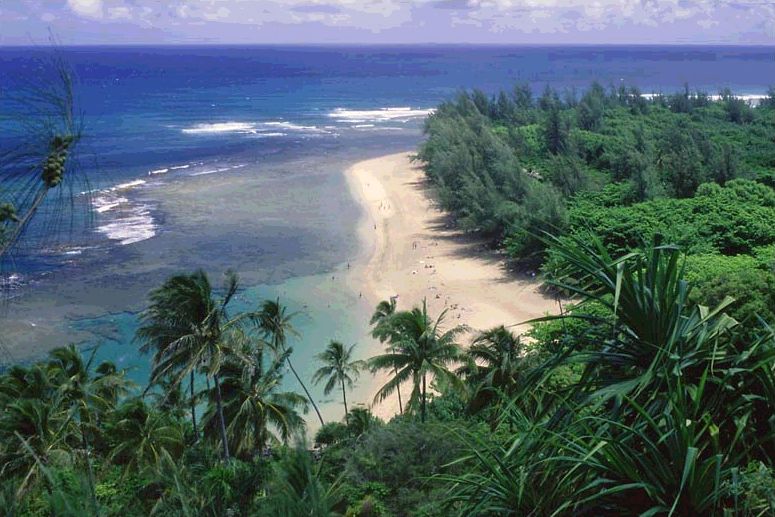 |
| . |
| HAWAIIAN SHORE FISHING |
| The Main Gamefish Species: |
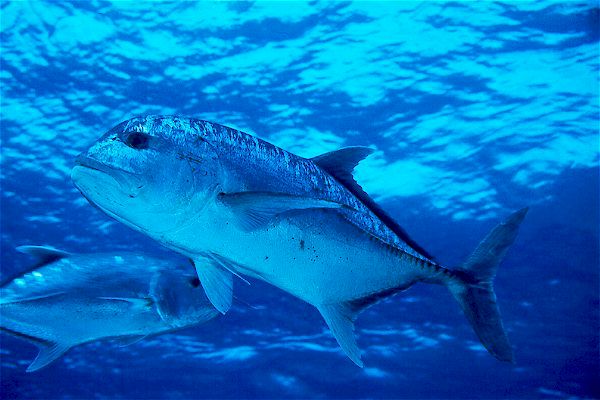 |
 |
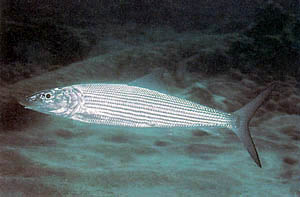 |
| ULUA |
| MOI |
| 'O'IO |
| You can learn about other reef fish and their fishing methods in my word document which you can download by clicking on the link below: Other Hawaiian Reef Fish and Fishing Methods |
| Ulua The Ultimate Hawaiian Gamefish |
| Description: In Hawaii, the word "ulua" actually refers to many member of the trevally family and the word "papio" is used to describe any ulua in it's juvenile stage of under 10 pounds. The two most common types of ulua found in Hawaiian waters are the white ulua and the omilu. White ulua, otherwise known as giant trevally, can reach weights of well over 100 pounds and it is even believed that there are some 200 pound uluas swimming around in hawaiian waters. Ulua are tough, down and dirty fighters who like to run the line around rocks and coral heads in an effort to free themselves and they come in all sizes from just a couple inches all the way up to 150 pounds or more. They average 10 to 25 pounds but fish of all sizes are out there. White ulua are found every where, from the tidal zone all the way down to depths of more than 500 feet, from reef to sand, and sometimes even in brackish water. The omilu or blue-fin trevally is almost the same fish but in a down-sized version and with different colors. In Hawaiian waters, omilu are only capable of reaching a little over 20 pounds and average around 8 pounds. Another difference from white ulua is the habitat they prefer. Omilu prefer reef environments and are rarely caught in sand. Because of their preference for reef, omilu are more common to catch while whipping (casting lures), a technique which is generally done over reefs. They can be found from the shoreline down to depths of over 500 feet and are common catches while dropping baits down to pinnacles or drop offs in deep water. |
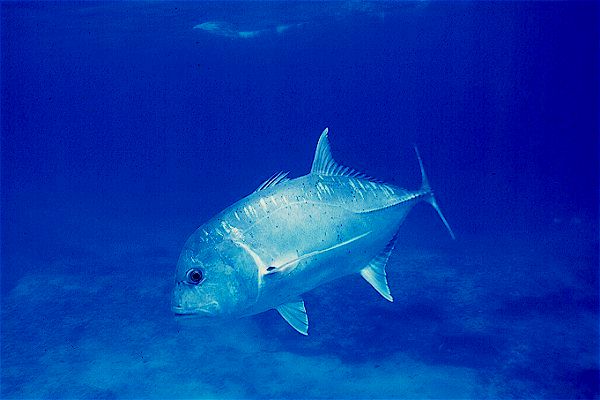 |
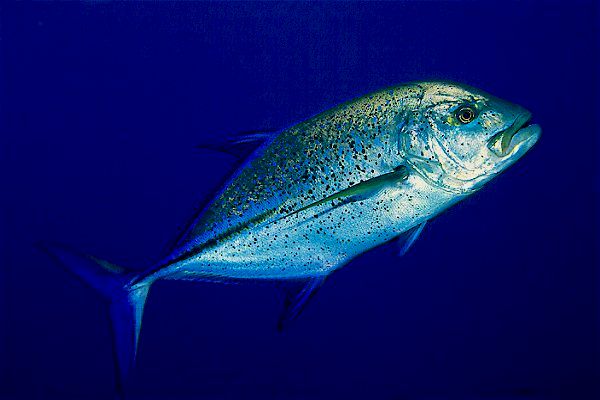 |
| White Ulua |
| Omilu |
| Fishing Methods: Whipping: Casting Lures Usually done over some sort of reef structure, whipping involves casting a lure out and retrieving it fast and erratically. It can be done with any rod making it the most popular fishing method in Hawaii. Poppers are the most popular lures for serious ulua whipping with many fishermen swearing by black pili poppers. I wrote another page on whipping and you can click on the link to read more but I am not an expert on whipping so do not take my advice too seriously. Whipping for Papio and Ulua. Serious Ulua Fishing Equipment Serious ulua fishing consists of using large baits on big Hawaiian-made surf poles known as Ulua Poles. These are heavy 12 to 14 foot poles with conventional reels in the jigmaster, 4/0, and even 6/0 sizes loaded with 50 to 80# test line. The preferred methods are slide baiting and baitcasting (dunking). Such large gear is needed because anglers are after big fish which are often tough enough to empty an entire spool of line. Slide Bait Fishing The most popular style of ulua fishing and indeed the method with the most big ulua to it's credit is the slide bait method in which a led weight is casted out, anchored, and then a large bait is slid down the line. A metal stop ring secures the slide bait buckle from going any further down the line and is the link that solidly attaches the slide to the line; sort of like trying to pull a big ring through a small ring. Read more on slide bait fishing. Baitcasting Where waters are shallow and waves are present, slide bait fishing might not be possible because of waves and the line angle. In these cases, the ulua fishermen might have no choice but to cast his or her bait out. This method of dunking is known as "baitcasting." Read more on Baitcasting. |
| Moi The Fish of Kings |
 |
| One of the best eating of the shore fish is the pacific threadfin locally known as moi. Moi are shallow water fish that live in rough sandy and rocky coastlines. They average 1.5 pounds and can occasionally reach sizes of over 10 pounds. The state record is just 9 pounds 8 ounces, caught on Oahu, but there are rumors of moi up to 20 pounds which have been caught and eaten without being entered into the record books. Their large broad tail and feelers under their belly help the moi to find their way and thrive in the roughest white water around. In such rough water, crabs can be knocked off of the rocks and rock hoppers and o'opu can easily fall into the water where the hungry moi are waiting. Moi are largely nocturnal schooling up in moi holes during the day and at night, the school spreads out to cover a broader area in search of food, but |
| moi will feed at any time of day or night, given the opportunity. In areas adjacent to sand beaches, the moi school will move out of the moi hole at night and move into the sand to search for sand turtles, ghost crabs, small fish, and just about anything else they can find. Moi can be caught while whipping, dunking, and thrownetting. In sand, they like to stay in the shallows inside or just off the edge of the surf. Dunking sand turtles, crab legs, shrimp, or cut bait in the sandy surf break at night proves to be an effective and popular method of fishing. Small circle hooks and Maruto MZ or Izuo AH hooks should be used. The bite will usually come as small shakes or a "tap-tap-tap". The mouth of the moi is soft, so one must be sure not to place too much pressure on the fish while bringing it in. 8 to 12# test line and a 10 foot soft rod is adequate but the moi is a strong fighter and a 5 pound moi can easily rip 100 feet of line off of a reel. One can also catch moi out of their holes during the day. These moi holes are usually located in rough whitewater where you cannot see past the waters surface. A hole in the reef, coral head, trench, or boulders can be all that is needed to give the fish protection from the current. In such waters, it is very difficult to maintain tight lines with the lure unless you are using a scrounger jig head. The scrounger is a basic lead head jig but with a plastic lip that extends upwards like a sail. When retrieving your lure, it acts to slow the lure helping to maintain tight line in the rough water and slowing the lure so that the moi can more easily find it and the lip even acts like a week guard against the rocks. A curly tail grub should be attached to it. Colors that work are clear with glitter, white, black, and motor oil. Bait can be used as well. The black a'ama rock crab is the best bait but anything will work. Jo-jo or rock skippers and o'opu are also good baits. They can be drifted through the holes or it it's calm enough, casted out with a weight. Moi in the holes are sketchy, so casts should overtake the hole and be retrieved into it. When a fish is hooked, it should be pulled out of the hole as quickly as possible to reduce the chances of spooking the school. Moi are great eating and can be fried, steamed, or baked. One can steam or boil the fish and then pour hot oil over it and then add soy sauce, ginger, and spices. Larger moi might have to be baked or barbecued. Cook them just like you would a parrotfish by wrapping them in ti-leaf with mayonnaise, butter, spices, sausage, vegetables, and then wrap it all in tin foil and cook until vegetables are done. The flesh of the fish, if cooked long enough, should fall apart to the touch and taste delicious! In ancient Hawaii, only the male ali'i (royalty) were allowed to eat moi and breaking this law was punished by death. Today, moi season is closed during the months of June, July, and August when the moi are spawning. Populations are low now in comparison to the past, so any moi caught during this time of year should be released unharmed so that they can spawn. This applies especially to the larger fish, which are though to be the females. |
| Bonefish fishing in Hawaii is very different from the flats fishing found in other parts of the world such as that of the Gulf of Mexico. Most o'io live in deeper water of 30 to 100 feet in huge schools. Only some of that school will actually come to the shoreline where surfcasters can hook them. It seems at times that the school will quickly make a pass close to shore at dawn and dusk and then will back off, but during that pass, the shore fishermen can experience fast action with all of the rods going off at once! But the bite can come at any time of the day or night (or not at all) so fishing should not be limited to either end of the day. There are places in the state where some o'io do cruise the flats just like they would in other parts of the world, but in much smaller numbers and in water which will rarely be shallow enough to spot tailing fish. O'io average around 5 pounds here in the islands and feed primary on sand worms and crustaceans but will also chase down small fish if the opportunity presents its self. Fishing should be done in the sand or sandy reef. In the surf where sandbars are present, one should look for channels on the down current side of the bar where the waves fade out, as that is where the o'io will hold. Sand channels are also main travel routes of o'io. If shore break is present, the lines should simply be cast outside of the surf, however the edge of the surf may serve as a travel route. The o'io school might also travel parrallel to the coast outside of the surf. It is wise to cast different poles to separate distances: for example one close to the edge of the breakers, one as far out as possible and one somewhere between the other two. The basic dunking rig consists of a lead weight in the pyramid shape with either one hook behind it, or one or two hooks on the line above it. The hooks used should be small to medium sized circle hooks or either Maruto MZ or Izuo AH hooks. For bait, strips of squid, shrimp, black rock crab, sand turtles, tako leg, and cut akule all work well and bonefish of Hawaii tend to be agressive feeders. The bonefish is known worldwide for being a strong fighter and can reach sizes of well over 15 lbs. so reels should be capable of holding plenty of line between 15# and 30# test. Serious o'io fishermen use downsized ulua poles called "o'io poles." Spinning rods are also popular and should be at least 10 foot long in order to help in cast past and hold line up over the waves. Strikes will come as a good tap and then a hard run. Lighter tackle also makes for some fun battles. Bonefish can be good eating if prepared properly but populations are not as high as in the past, so for conservation purposes, catch and release should be practiced. If you do plan to eat o'io, keep only what you need and then release the rest because o'io are more valuable as a sport fish than as a food fish. My personal oppinion on o'io taste of the flesh is that it is similar to a blend between salmon and tuna. |
 |
| 'O'io |
| Bonefish in Hawaii |
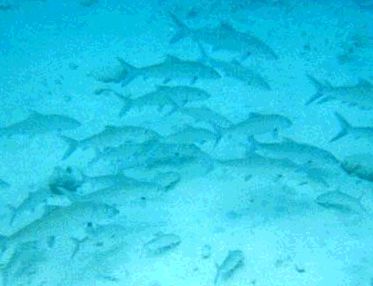 |
| Note that no saltwater fishing licence is required here in Hawaii but one should read the Hawaii Fishing Regulations manual and familiarize themselves with any restrictions that exist as well as any seasons, size and bag limits that exist. |
| by Nicolai Barca |